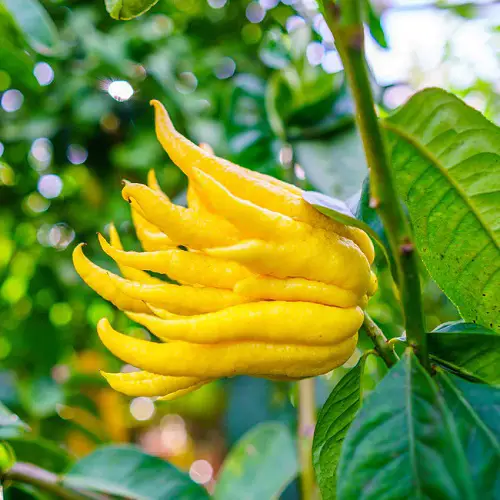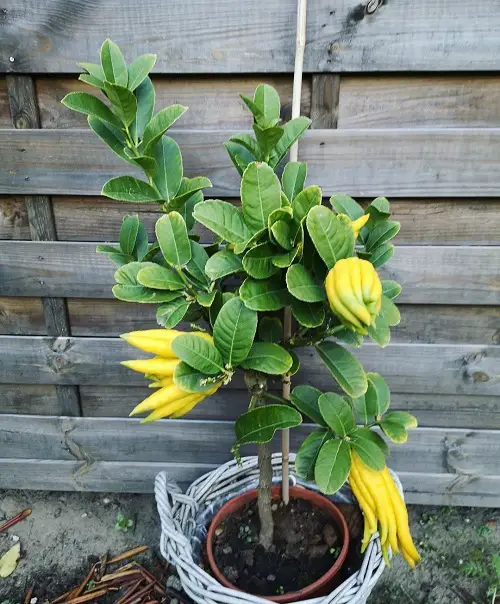Growing Buddha’s Hand Citron is not difficult, and you can have it in your garden! Let’s have a look at How to Grow Buddha’s Hand!

If you want to try growing a new citrus variety, then Growing Buddha’s Hand Citron is the best choice! Here are all the details on How to Grow Buddha’s Hand!
USDA Zones: 9-11
Other Names: Citrus medica, bushukan, fingered citron, fragrant citron, five-finger mandarin, goblin fingers
Learn How to Keep Gerbera Daisies Blooming here
Buddha’s Hand Information
Buddha’s hand citron is an evergreen, large thorny shrub or small tree that grows up to 3 to 5 meters tall (10-18 feet)
Native to North East India and China, Buddha’s Hand is a member of the citrus family and is also called Buddha’s Finger because of its unusual and fragmented finger-like fruits. These fingers form a cluster like a hand and can be between 5 to 20 in number.
Here are the Best Green Fruits with Pictures
Growing Buddha’s Hand

Buddha’s hand plant can be grown from cuttings and seeds. However, as it can be a time-consuming process, it’s best to find a well-grafted plant from the garden center.
If you’re about to grow it in a cold climate, planting should be done in spring to early summer when the temperature starts to warm up and in containers. This way, the plant gets established before the onset of winter as well.
In tropical climates, planting can be done in any season except summer; right after the end of summer is the best planting time.
Note: You can grow Buddha’s hand from fresh seeds. However, it is true that its seeds are rare.
Check out these Cold Hardy Tropical Plants to Create a Tropical Garden in Cold Climate
Requirements for Growing Buddha’s Hand Citron

Sunlight
Like all citrus, Buddha’s Hand Citron needs plenty of sunlight to grow well and produce ample fruits. Choose a location that gets a minimum of 5-6 hours of direct and intense sunlight every day.
Remember the simple rule – the more sunlight the plant is going to get, the better it will be for its growth and fruiting. Avoid keeping it in a shaded location.
Here are Plants that Grow Without Sunlight
Soil
Use a well-draining potting mix with a lot of organic matter and aged manure. For best growth and fruits, the pH of the soil should be 5.5-7.
You can also use an equal mix of garden soil, perlite or vermiculite, and any organic matter.
Watering
Check topsoil by poking your finger before watering. On hot days, the plant requires more watering and slightly moist soil. In any case, do not water the plant on a daily basis, and also ensure that the growing medium is never going completely dry.
Here are Signs of Overwatering & How to Save an Overwatered Plant
Temperature
The ideal temperature for growing Buddha’s Hand Citron is around 65 F (18 C). They do well in the temperature range of 50-100 F (10-38 C).
Buddha’s Hand Care

Fertilizer
An 8-8-8 or 10-10-10 liquid fertilizer, diluted to 1/2 of its strength (you can also use full strength), once in 4-5 weeks will provide all the boost the plant needs to grow plenty of fruits. The best time to fertilize is during spring and summer.
Here are Effective Homemade Lawn Fertilizers That Are Safe From Hazardous Chemicals
Pruning
Prune regularly to keep the growth of the plant in check and also to keep it in shape. Eliminate dead wood and prune the inside of the plant to make it less cluttered so that the sunlight reaches the center of the plant.
If you live in warmer regions, prune the plant in spring, between Feb and April. For colder areas, prune between Feb and March.
Pests and Diseases
Buddha’s Hand has similar pests and disease problems as you see in other citrus varieties. Fruit rot, Brown rot, leaf miner, spider mites, cochineal, aphids, and scales can affect the plant.
Keep them at bay using insecticidal soap. Also, avoid overwatering and wetting the foliage to keep most of the potential diseases at bay.
Here are DIY Insecticidal Soap Recipes for the Garden to Kill Pests
How Buddha’s Hand Citron Tastes Like?
This quirky-looking fruit has a taste that’s a mix of sweet and sour. Take it as a mixture of a taste of orange and lemon with the notes of orange on the stronger side.



I have a buddha hand tree. It is growing, flowering, and making fruit. However the new leaves shrivel and curl up. This is also happening to my tangerine tree.
What do I need to do to solve this problem.
Our nursery suggested spraying the tree with a high pressure hose daily and then spray with an organic pesticide like “Captain Jack’s”
I faced similar problem. Been oil spray once in 7-10 days will control it.
My Buddha hand tree lost it’s ‘fingers’ and now has round, dark green fruit instead! Is there an explanation for this?
it transformed to Buddha balls ! thats also very good citrus !
Mine did also and atta closer look I was horrified to find spider mites galore. I sprayed mine with a neem oil diluted with water as per manufactures directions. I had to spray twice until the didn’t come back. I still check it regularly.
what rate of dilution. how much to how much water
I have had my Buddha hand plant for approximately 3 years. It had not produced any fruit. I live in upstate New York. Is the climate to cold?
Can you prune branches without harming the tree? We live on the coast of South Carolina (Charleston)
Thank you!
Would like to get some cuttings to grow in a big greenhouse un Norway.
Hi,
I have a budda’s hand tree and have so for the past 5 yrs.
I started it just as a cutting and waited a year before it
showed any life at all.
These past couple of years I have planted it in a garden area
which is very sheltered, and it is now two and a half metres tall.
It has a long main leader with a couple of side branches.
What age does it need to be to start fruiting.?
Can I cut it back a bit, or should I cut it back.?
Thanks
Graham Hallam
Hamilton, New Zealand.
From where I will get green budha cytrus grafted plant . Please give me contect persons name and number .
Please tel me cost of grafted plant